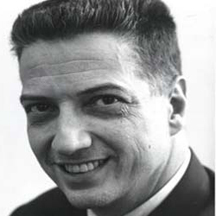John Hammond (December 15, 1910 – July 10, 1987) was an American record producer, civil rights activist and music critic from the 1930s to the early 1980s. In his service as a talent scout, Hammond became one of the most influential figures in 20th century popular music. Hammond was instrumental in sparking or furthering numerous musical careers, including those of Bob Dylan, Bruce Springsteen, Benny Goodman, Harry James, Charlie Christian, Billie Holiday, Count Basie, Teddy Wilson, Big Joe Turner, Pete Seeger, Babatunde Olatunji, Aretha Franklin, George Benson, Freddie Green, Leonard Cohen, Arthur Russell, Jim Copp, Asha Puthli, and Stevie Ray Vaughan. He is also largely responsible for the revival of delta blues artist Robert Johnson’s music. (More from Wikipedia)
The first Bob Dylan album, Bob Dylan was released with great fanfare by Columbia Records in March 1962; it is a relatively conventional folk album that is not unlike those that Joan Baez, Judy Collins, and Peter, Paul and Mary were recording at the time, with just two original songs. The album was produced by John H. Hammond, the legendary talent scout who signed Bob Dylan to Columbia. Though excellent in every way – for instance, the album includes “Man of Constant Sorrow”, the song (as performed by the Soggy Bottom Boys, with George Clooney on lead vocals) that was made famous in the 2000 Coen Brothers film O Brother Where Art Thou – Bob Dylan sold just 5,000 copies initially; and Columbia Records executives began grumbling about Dylan’s being “Hammond’s folly”.
* * *
As the months dragged on in the recording sessions for The Freewheelin’ Bob Dylan, producer John Hammond might have begun feeling a little out of his depth – no doubt he knew that he had the goods this time. He was also having power struggles with Albert Grossman, who became Bob Dylan’s manager on August 20, 1962. Additionally, Bob Dylan first started making recordings with a backing band in October 1962.
At any rate, another producer was brought in to help out – an unlikely though inspired choice as it turned out. As described in Wikipedia: “Because of [Albert] Grossman’s hostility to [John] Hammond, Columbia paired Dylan with a young, African-American jazz producer, Tom Wilson. Wilson recalled: ‘I didn’t even particularly like folk music. I’d been recording Sun Ra and [John] Coltrane. . . . I thought folk music was for the dumb guys. [Dylan] played like the dumb guys, but then these words came out. I was flabbergasted.’”
(June 2013/2)
* * *
As I wrote about Bob Dylan in my last post, his first album, Bob Dylan sold modestly; and Dylan became known as “Hammond’s Folly” around Columbia Records – John H. Hammond had decided to sign Dylan on the spot after hearing him perform on September 14, 1961 at the apartment of Carolyn Hester and Richard Fariña (two folksingers that I also wrote about last month), though he evidently made a formal audition first (no recorded evidence of that audition survives, unfortunately).
(April 2015/1)















